The Royal Air Force’s swarming drone project is understood to be “exceeding expectations”, with 216 Squadron preparing for the role of operating the RAF’s future fleet of network enabled drones.
Baroness Stern, asked via a written question:
“To ask Her Majesty’s Government what progress has been made on (1) the ‘Mosquito’ project, (2) the ‘Many Drones Make Light Work’ programme, and (3) other work to network-enabled or ‘swarm’ drones; and when they anticipate such network-enabled drone capability to be operational.”
Baroness Goldie, Minister of State at the Ministry of Defence, replied:
“Project Mosquito is a technology demonstration being conducted in two phases. Phase 1 is complete, and the Ministry of Defence is currently evaluating the proposals for Phase 2. As Project Mosquito is a technology demonstrator, it is not anticipated that the project will result in an operational capability. The Many Drones Make Light Work project explores the technical feasibility and military use of a swarm of up to twenty small unmanned aircraft vehicles, operating under the control of one individual. The project is in its final phase, Phase 3, delivering a structured flight evaluation programme of this new capability with the successful first trials held in March 2020.
The Royal Air Force’s swarming drones project continues to be developed by the Rapid Capabilities Office with progress during recent trials exceeding expectations in several areas. Following the successful first trials, 216 Squadron was reformed at RAF Waddington on 1 April 2020. They will take on the operating role for the RAF’s fleet of network enabled drones.”
Last year, the MoD awarded £2.5m to a consortium led by Blue Bear Systems Research Ltd to develop the drone swarm technology. The Ministry of Defence say that a swarm could support lower operating costs, greater system efficiency as well as increased resilience in the following areas:
- Situational awareness
- Medical assistance
- Logistics resupply
- Explosive ordnance detection and disposal
- Confusion and deception
According to a news release from the MoD last year:
“Currently, operational systems require one or more operators to pilot the aircraft or to closely manage the flight mission. This is manpower intensive and consumes time and resource to train operators. The UK Armed Forces are actively seeking robotic solutions to provide a ‘Force-Multiplier’ effect whereby a greater military capability is delivered by fewer people and equipment. The swarm system is one possible solution to this multiple domain requirement as it will cover larger areas of battlespace more quickly at lower cost and reduced man hours. It also removes the operator from potentially harmful situations.
The future project phase will seek to establish a more ‘self-sufficient’ UAS swarm, providing the military with the ability to operate in increasingly complex and contested environments. Effective Human Machine Teaming will remain at the core of this research to ensure that the human remains firmly in control of the system.”
The other project mentioned, Project Mosquito, is part of the wider Lightweight Affordable Novel Combat Aircraft (LANCA) concept based around offering increased protection, survivability and information to inform the development of an operational concept in the future.
The MoD said in a release last year:
“Under LANCA, a technology demonstrator project known as ‘Mosquito’ has awarded contracts for Phase 1 of the work, which will produce a preliminary system design for an unmanned air vehicle and assessment of the key risk areas and cost-capability trade-offs for an operational concept. Initial flight test of the demonstrator air vehicle could take place as early as 2022. Phase 1 will include the exploration of novel design, development, prototyping, manufacture, and support, to enable low-cost rapid development and evolution of a potential future unmanned combat air system. Dstl, which provides science and technology for the defence and security of the UK, is delivering the technical oversight, project management, and partnering for Project Mosquito.”
For Phase 1, contracts were awarded to three teams led by Blue Bear Systems Research Ltd, Boeing Defence UK Ltd, and Callen-Lenz (Team BLACKDAWN partnered with Bombardier Belfast and Northrop Grumman UK Ltd). LANCA originated in 2015 studies to understand innovative Combat Air technologies and concepts that might offer radical reductions in cost and development time. Subsequently LANCA was brought into the RAF RCO as part of the Future Combat Air System Technology Initiative (FCAS TI).
Project Mosquito has two planned phases. After the 12-month Phase 1, Phase 2 will select up to two of the Phase 1 solutions to further mature the designs, complete manufacturing of the technology demonstrator and conclude with a limited flight-test programme.


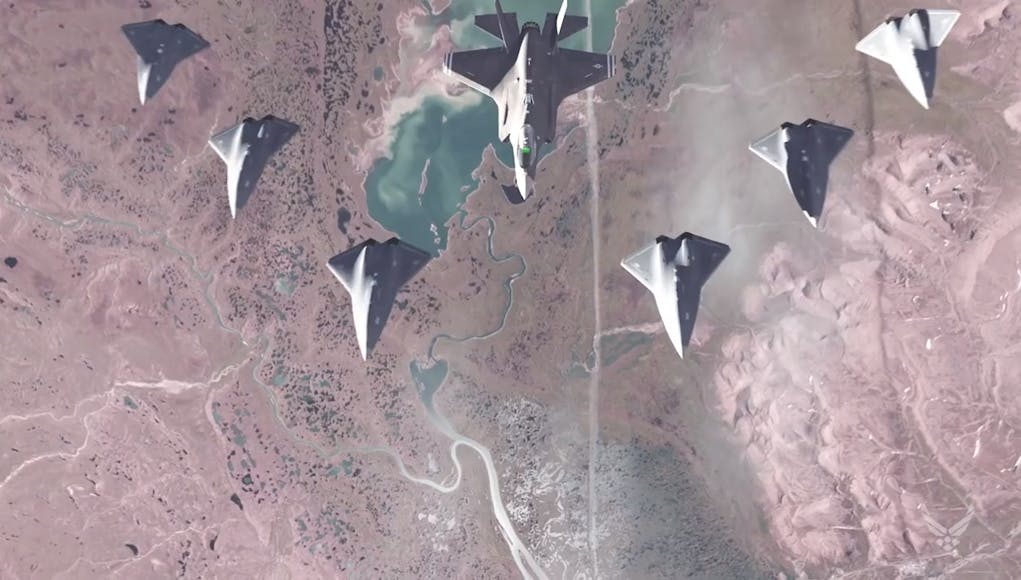




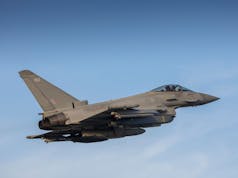

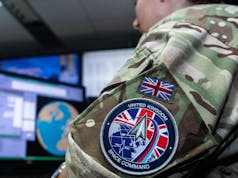
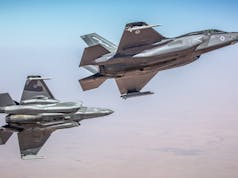
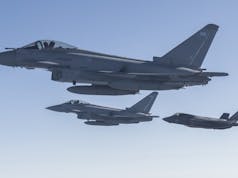


AWESOME!
While not wishing to sound like a buzzkill, we were also told that the NHS Track and Trace app was doing brilliantly well, and look how that turned out. I think it would be prudent to hold back on effusive praise until there is public proof of what we are being told, beyond ministers answering questions in Parliament.
If it’s not going to lead to an operational capability being deployed, what is the use of these pilot trials?
I think her point was, at the end of this particular process we will not have a deployable asset. However the lessons learned will allow the implementation of such assets, at some point in the future.
Techno demos allow the military branch to see that what they want is possible with existing/recently developed technology, they can then agree contracts, unit prices and lead times etc and set in service dates… if funding is allocated.
That’s the thing though. We’ve had endless trials of UAV systems for what seems a decade or more “informing” and then nothing happens at the end of it. No order for kit, but…another trial to inform!
The sceptic in me just thinks FRES, all over again.
Did Australia / Boeing go through endless informing trials with Loyal Wingman? Happy to be corrected it the did.
The fact that the RCO is involved would suggest something will come to fruition.
Was it not the RCO that dealt with all of the Telic/Herrick UOR’s that rushed multiple new vehicle type & equipment in to service?
Ignore that, it wasn’t formed until 2016!
The RCO is purely aircraft related. It would be nice to think there is an equivalent in the Navy and Army?
A reasonable observation Daniele. However, the counter example for UAVs is Watchkeeper, with total program cost north of £1.1bn at this point, i.e. conservatively two fully equipped T31s or ~250 Boxers etc etc.
There are a lot of tiers of UAV solutions, used either singly or increasingly in teams, and consequently there are a lot of ways to invest in poor and/or incorrect solutions IMO. So at this point it might be worth figuring out first what problems we are trying to solve and whether the solutions we are considering can adequately address them.
Consider Watchkeeper again. Maybe fine as a solution for counter insurgency, where one is likely to control the airspace and also have access to suitable launch and recovery locations. But how does Watchkeeper stack up in a peer or near-peer contested airspace? I don’t know but I suspect it may be rather vulnerable given that a number of Hermes 450 have been shot down in use. If that’s the case then where do we expect to use them to get a return on the investment?
There are two opposing views on how well a UAV such as Watchkeeper may perform in a peer vs peer conflict. Two extreme examples being the Ukraine and Syria conflicts. The border grab between Russian separatists and Ukraine was initially one sided in favour of the separatists. They have had direct backing from Russia, including UAVs. Initially the UAVs were countered with MANPADS and lots of small arms. However, today Ukraine has developed electronic countermeasures and has become very adept at dealing with them. Meanwhile, both sides have further developed their UAVs to be less effected by ECM. They still use commercial off the shelf drones including the “toy” ones. These are use for checking buildings etc.
Meanwhile in Syria, we saw RC planes converted to UAVs bomb trucks, that required shooting down by Russian Pantsir systems. However, we also saw Israeli UAVs make a mockery of the Pantsir system, roaming freely over the Syrian border. With a number of these doing suicide missions against planned targets and targets of opportunity.
So the outcome from the two conflicts is that non-stealthy UAVs can still effectively play their part. However, as the conflict develops, both sides will produce better countermeasures and more effective UAVs.
Thanks Davey. Let’s hope Watchkeeper shares the same apparent immunity of your last example. Have to say I’m a bit skeptical though, given Iran’s ability to shoot down the US RQ-4A. One would have thought the RQ-4A to possess significant counter capabilities based on its cost, despite being a prototype for, rather than the full production version of, the MQ-4C Triton.
Morning GHF. I give way to Davey’s wider expertise on UAV above.
My own view on Watchkeeper probably mirrors your own, in that equipping 2 batteries worth over a decade for over 1 billion is not efficient. By a hundred new Tanks or as you say some fully armed T31 for that.
Aus are 5 steps in front. Amazing what a coherent and aligned organisation can do isn’t it?
We’ve been left behind because everyone in the DSTL is a bloody expert and their ‘expertise’ sucks the R&D pot dry. Their musings and testing takes more time than it does to get something in production.
In fact, one of the UKs biggest exports is ‘expertise’ FFS.
On the other hand, watch keeper. A colossal fuck up of epic proportions that proves we’re better thinkers than doers.
Not that long ago we could do both. The advances in tech WW2 produced was nothing short of impressive. We’re still learning today about the out the box stuff they put together.
Self eating snake springs to mind at the moment.
A swarm of drones controlled via AI?
All well and good until they go back in time to try to kill Sarah Connor!
Using a plasma rifle in the 40 watt range no doubt.
Have to make do with an Uzi 9mm, until then though!
Wasn’t it announced last year that we were buying off the shelf drones that would be operational before the end of the year (end of 2019). Not sure how 6 months late and no actual physical product is exceeding expectations.
Ah yes, exceeding expectations
https://ukdefencejournal.org.uk/announced-drone-swarm-may-not-be-ready-by-end-of-2019-despite-announcement/
An incredible force multiplier which is very far along, having one person control 20 drones and pilot the aircraft at the same time is a major breakthrough.
At that ratio we would need many hundreds of these at least.
One aircraft could possibly patrol the whole GIUK gap, or Russia’s entire western border.
They could be loaded with Spear 3’s and even crash into things.
The QE carriers will hopefully be able to find a way to use these, though I have no idea how that would be done.
Surely a lightweight drone could have a much higher thrust to weight ratio? That could allow them to take off at least, just leaving some form of trap solution – again lightweight if the drones aren’t too heavy.
It really depends how big these things are as size will massively impact endurance.
What isn’t clear is whether the mother-ship aircraft is meant to launch these or just pilot them, in other words are they in practice just bombs that can glide for a bit or real planes in their own right.
That’s a great question. What alternatives I wonder. 1) a few carried by an aircraft like Typhoon, F35 or Tempest 2) they take off or are launched independently from a base or warships 3) they are launched from a mother aircraft of military transport size sitting well back from the other aircraft in swarms as and when manned aircraft might need them or to work independently of them in their own right. Is there any other alternatives?
It might depend on the mission. Escorting a fighter they would probably take off with it, but during a surveillance mission the drones could be distributed and launched from nearer their patrol areas to cut down on transit time, they could work in a chain with laser comms between them and the manned fighter.
The picture makes it look like they are near jet sized, but i suspect the reality will be they will be closer to missile sized.
The question is what exactly will there role be. It cool etc having them but they need to bring something useful to the party.
It says they will be used to increase efficiency and resilience in..
Situational awareness
Medical assistance
Logistics resupply
Explosive ordnance detection and disposal
Confusion and deception
Some of which imply they are capable of carrying cargo/weapons.
I hope they are of a similar size to the Loyal Wingman program, but they are probably smaller and cheaper because we should have so many of them and we should be prepared for plenty of losses.
If these drones are much smaller than the mother ship (F35 for example) then won’t the range be much smaller? Am i wrong in thinking that much smaller craft with ordinance will have a much smaller mission range.
You do save a lot of space by not having a pilot and the engines don’t need the performance of a fighter, but it is going to be a small drone so it can’t have too much range, but then the F-35B only has 1000 miles.
Also, these drones might be on a one-way mission.
Andy is right that a lot of capability in a fighter is taken up by carrying the pilot and cockpit. Drones can have huge ranges though with endurance measured in days but endurance usually comes at tje cost of speed. Unless going for drones which are essentially missiles with glide capability (which has been done before) its likely the swarm would have to be launched ahead of the mothership and it would catch them up.
What happened to the BAE Taranis project? Does anyone know if any of that work was fed into this project?
Taranis is about the size of a Hawk trainer and has two internal weapons bays so its very unlikely to be a candidate for swarming. We might expect a derivative of Taranis to be part of the Tempest program in the role of loyal wingman. Back in 2014 the RAF were setting an expectation for a post-2030 operational Taranis derivative platform.
It is also conceivable IMO that the manned aircraft in the Tempest program might look more like Taranis than the concept placeholder that was rolled out at the Tempest launch. In other words designed not only for low all-aspect RCS, but also low all-aspect thermal and sound signatures. Its also not inconceivable that the same platform might be used for both, given that the Tempest aircraft is also including an optionally manned role.
UK government declined to fund the next stage of the project (development of a full scale test vehicle) so France had to go it alone. BAE and its partners will have benefitted from 10 years of stealth drone research.
We can’t even get the drone projects we’ve had for 10 years or longer off the ground
As for what they think it will do
Situational awareness – so do the drones we have now
Medical assistance? maybe to locate personnel otherwise what does this mean? Drop a tube of Germolene and a plaster off?
Logistics resupply, surely it can’t be big enough to carry anything only locate a drop zone and overwatch.
Explosive ordnance detection and disposal – so do the drones we have now I think?
Confusion and deception- fly above the enemy and do what? Say shoot at me instead
But can’t shoot back and has to loiter until an RN Ship or Typhoon or F35 shoots
A clear explanation of each of its future roles is needed! So let wait and see…
Unless this is a large fully armed drone with ISTAR able to swarm and be survivable and that will make it a force multiplier.
It sounds too good to be true and doesn’t make much sense at this point or maybe I’ve not had enough coffee yet! ;P
I think the money could be spent elsewhere otherwise
I think that there will be a number of UAVs requirements that fall out of this that require multiple types of UAV. As I don’t believe we have the technology yet, where one drone can fulfill all requirements.
If you look at the loyal wingman that Boeing is building for Australia, it’s huge. It is 38 feet long or about two-thirds as long as a F/A-18 Super Hornet fighter, with a range of 2,000 nautical miles (2,301 miles). This puts it in the manned/unmanned league. The requirement for this aircraft is not only to act as a loyal wingman, i.e. bomb truck and additional sensor platform for a F35/F18, but also has the ability to carryout missions on its own. The BAe Taranis also falls into this category, but is more aligned as a strike and reconnaissance platform than the Wingman. Which has been designed with an eye to dogfighting.
These two platforms are designed to be recoverable, however there are designs out there that are for one way missions only. One of these concepts is where a swarm of them are released out of the back of a Hercules. These are more in the Watchkeeper size. They need to be this big to carry a useful payload a sizeable distance. There have also been some designs which can be carried by a fighter. These are then released to scout ahead acting as a remote sensor platform for the mother aircraft. Again these are one way only. But also has the issue of taking up a payload space on the aircraft. So expect to see these UAVs not only acting as sensors, but also as a suicide drone against ground targets.
For combat air patrols, what’s really required is the Boeing loyal wingman size of aircraft. This is because it has to probably act as a bomb truck for its mothership/paired manned aircraft. Therefore it will need either a bomb bay and/or strengthened wings to carry weapons. It needs the fuel capacity for the duration this task requires and/or the ability for air to air refueling. It will also need the performance to keep up with and possible engage other aircraft. Therefore it will need a respectable engine. So an aircraft such as this will need to be large but should be cheaper than a manned aircraft, though not significantly! It will still require sensors for searching for targets and then tracking them. It will then need a secure means where data can be transferred without being intercepted or hacked. Then it will also need a capable AI to manage not only its flight controls and navigation, but how to respond to threats and perhaps faults.
We have seen Watchkeeper take years to get to where it is now. The problem was never the airframe or control from the ground station. The issue was that we required the UAV to operate in civilian airspace. This meant it had to be able to respond to aircraft flying around it. A good example of how difficult this has been to achieve is to look at Tesla’s driving aids for its cars. How many times has it been reported that the vehicle on “auto-pilot” drove into another vehicle etc, beacuse it didn’t “see” it? For an aircraft to be certified, that is far too many. The CAA quite rightly enforced the requirements. It is one of the reasons you never see or here about Reaper flying from the UK. It simply isn’t allowed to as the AI is not intelligent enough. When the Protector flew across the pond to the International Air Tatoo. The aircraft was met out at sea by a Typhoon, which sheparded it all the way to Fairford. There was another ground station at Fairford to “guide” it in. There have been other UAVs that tried and failed to meet these requirements. A very good example was the Global Hawk that Germany tried to use. They walked away from the project after sinking $2.5 billion in the program. It failed to get air worthiness clearance from the European Union Aviation Safety Agency (EASA).
To summarize, it is easy to design a UAV to that can do some of the tasking a manned aircraft can do in a benign environment and control it via a ground station. But to enable it to safely navigate (on its own) through congested airspace is significantly harder to achieve, especially when it needs to react to things like paragliders etc which may or may not have a Traffic Avoidance System (TAS) fitted.
You could probably turn that response and others into a series of primers on UAVs and have George publish it. Judging by many comments there’s a lot of confusion around UAVs.
I agree. For instance a small squad UAV will have a significantly different requirement to a loyal wingman type. Again it’s all about the context. For instance aircraft like the Wedgetail may have a pair of loyal wingman acting as personal close protection. Whilst something like Typhoon may carry a pair of disposable UAVs that are used as decoys. There are so many possibilities that you could use a UAV to not only carryout missions on its own, but also as force multipliers for manned missions.
The Rapid Capability Office will have a number of difficult decisions to make trying to nail down how to fulfill these requirements. But also making sure the inevitable mission creep doesn’t slow down the process.
Hi Harold,
I was wondering if you had any examples of any countries lowering defence spending?
Did I hear someone mention Watchkeeper? Mmmmmm? Quote from a Watchkeeper “pilot” while drinking a large amount of rum in my garden…cough… I quote
“Fucking old Watchkeeper shite, flying turd, shit sensors, can’t bomb no cunt, a bitch to turn quickly, no spares to fix the shit ones we broke on landing and flys like a fat disabled bloke trying to swim”!
I do appreciate this is not exactly a technical description of its capabilities, and I have redacted the slurring and scratching of bollocks while talking, but, it’s good enough for me! AI is the way forward, UAVs are essential, but thet do need to be modern and network enabled. Cheers.
The Watchkeeper for what it was originally intended for, I think matched the requirements. But that was back in 2007, with the first flight in 2010. Technology has moved on since then. For some reason we took away the manual control and relied on just the waypoint navigation method. The loss of two Watchkeepers has been attributed to the flight control software losing flight dynamic sensors and not having a manual back-up, so an operator/pilot could take over. Much like the 737 Max issue, Watchkeeper’s flight control software couldn’t cope when it lost an input from a pitot probe. The RA have lost at least 5 Watchkeepers so far.
The Royal Artillery were initially just after a spotter. But again, requirements move on. Why just have a spotter, when you can have a platform that can engage targets of opportunity. The issue then is that you want the UAV to actively hunt targets, which means it needs to get a lot closer to the forward line of operations. Rather than observing from a stand-off distance. For this kind of role the Watchkeeper based on the Hermes 450 is not suited. For starters it relies on its small size to remain unseen. If it’s operating near the front line, even a Shilka will spot it. If we were in a peer vs peer conflict I’m not sure how long a Watchkeeper would last?
For this kind of role, the RA would need a much stealthier drone. This would push the cost up significantly, especially when you have to design in a low noise footprint with a low IR and RF signature. Along with sensors and an advanced AI, allowing the aircraft to fly in congested airspace. For a UAV to have a chance in surviving in a conflict where there is a lot of air defence systems. It would need to be designed along the lines of Taranis, especially if you now wanted it to carry weapons. But as the Ukranians have found sometimes its better to have a lot of cheap and simple UAVs that are plentiful and easily replaceable. Especially when the opposition waste a significant amount of manpads countering them.
I think my mate was trying to say the same thing Davey, but had issues with his vocabulary due to a vast amount of Sailor Jerries ?! Cheers.
Oh dear a cut and paste response to a number of other stories Harold! Come on son, you have to work harder than that to get your 2 litres of two stroke and the weekly bucket of potatoes!